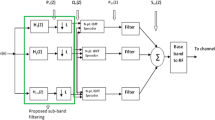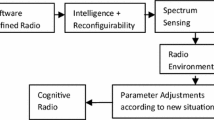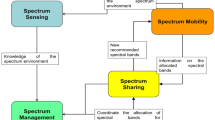Abstract
This paper provides the detailed simulation analysis of Filter Bank Multicarrier Cognitive Radio for doing tradeoff between the parameters of cognitive radio for achieving optimum performance. An attempt for tradeoff between different transmission-radio environment parameters has been done as this leads to an increase in spectrum efficiency by decreasing the spectral leakage which provides optimal performance. The optimization-tradeoff between different radio environment parameters is necessary for prediction and planning of future wireless communication systems. Transmission, reception and radio environment parameters play a key role in the performance enhancement of FBMC cognitive radio.








































Similar content being viewed by others
References
Schaich, F. (2010). Filterbank based multi carrier transmission (FBMC) evolving OFDM: FBMC in the context of WiMAX. In Proceedings of European wireless conference (EW) (pp. 1051–1058), Lucca, Italy.
Lélé, C., Javaudin, J., Legouable, R., Skrzypczak, A., & Siohan, P. (2008). Channel estimation methods for preamble-based OFDM/OQAM modulations. European Transactions on Telecommunications, 19(7), 741–750.
Du, J., & Signell, S. (2008). Pulse shape adaptivity in OFDM/OQAM systems. In Proceedings of international conference on advanced Infocomm Technology, China.
Kozek, W., & Molisch, A. (1998). Nonorthogonal pulseshapes for multicarrier communications in doubly dispersive channels. IEEE Journal on Selected Areas in Communications, 16(8), 1579–1589.
Trigui, I., Siala, M., Affes, S., Stephenne, A., & Boujemâa, H. (2007). Optimum pulse shaping for OFDM/BFDM systems operating in time varying multi-path channels. In Proceedings of IEEE global telecommunications conference (pp. 3817–3821), USA.
Du, J., & Signell, S. (2007). Classic OFDM systems and pulse-shaping OFDM/OQAM systems. Technical Report. KTH—Royal Institute of Technology, pp. 1–32.
Bolcskei, H., Duhamel, P., & Hleiss, R. (1999). Design of pulse shaping OFDM/OQAM systems for high data-rate transmission over wireless channels. In Proceedings of IEEE international conference on communication (ICC) (Vol. 1, pp. 559–564), Canada.
Haas, R., & Belfiore, J. (1997). A time-frequency well-localized pulse for multiple carrier transmission. Wireless Personal Communications, 5(1), 1–18.
Strohmer, T., & Beaver, S. (2003). Optimal OFDM design for time-frequency dispersive channels. IEEE Transactions on Communications, 51(7), 1111–1122.
Martin, K. W. (1998). Small side-lobe filter design for multi tone data communication applications. IEEE Transactions on Circuits and Systems II: Analog and Digital Signal Processing, 45(8), 1155–1161.
Amini, P., Kempter, R., Chen, R. R., Lin, L., & Farhang-Boroujeny, B. (2005). Filter bank multitone: A physical layer candidate for cognitive radios. Software defined radio technical conference (SDR 2005), California, 14–18 November 2005.
Amini, P., Azarnasab, E., Akoum, S., Mao, X., Rao, H., & Farhang-Bouroujeny, B. (2007). Implementation of a cognitive radio modem. In Software defined radio technical conference, Denver, CO, 5–9 November 2007.
Renfors, M. PHYDYAS:D5.1 Report. Tampere University of Technology, Finland.
Phydas Report. (2009). Prototype filter and filter bank structure optimization (pp. 1–102).
Zhao, O., & Sadler, B. M. (2007). A survey of dynamic spectrum access. IEEE Signal Processing Magazine, 24(3), 79–89.
Kang, A. S., & Vig, R. (2014). Comparative performance analysis of modified FBMC prototype filter under strategic conditions. European Journal of Scientific Research, 125(3), 362–369.
Kang, A. S., & Vig, R. (2015). Computer aided BER performance analysis of Filter Bank Multicarrier based cognitive radio under binary symmetric radio fading channel. Springer Journal of Wireless Personal Communication, 81(2), 15.
Kang, A. S., & Vig, R. (2016). Comparatative performance evaluation of modified prototype Filter Bank Multi Carrier cognitive radio under constraints of Lp, K, N and D. The Computer Journal, 59(3), 1–13.
Kang, A. S., Vig, R., et al. (2016). Comparative analysis of Energy Detection spectrum sensing of cognitive radio under Wireless Environment using SEAMCAT. International Journal of Advanced Computer Science and Applications, 7(1), 493–498.
Kang, A. S., & Sharma, V. (2016). Effect of prototype filter length on PAPR reduction and side lobe tail attenuation on autocorrelation in FBMC cognitive radio. International Journal of Advanced Information Systems & Technology, 51, 38–48.
Acknowledgements
The first author is thankful to Prof. Dr. Jasvir Singh, Department of Electronics Technology, GNDU, Amritsar for valuable discussion on the present topic. The help rendered by Prof. B. P. Patil, Army Institute of Technology, Pune is also acknowledged.
Author information
Authors and Affiliations
Corresponding author
Rights and permissions
About this article
Cite this article
Kang, A.S., Vig, R. Performance analysis of FBMC-CR through optimization: tradeoff between various performance parameters in the cognitive radio environment. Telecommun Syst 65, 567–589 (2017). https://doi.org/10.1007/s11235-016-0252-5
Published:
Issue Date:
DOI: https://doi.org/10.1007/s11235-016-0252-5




